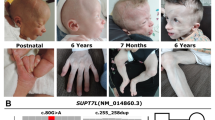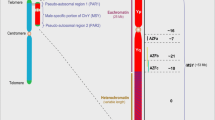Abstract
Ullrich-Turner syndrome (UTS) is frequently associated with monosomy X but may also occur with structural aberrations of the X and the Y chromosomes. It has been hypothesized that the ribosomal protein genes RPS4X and RPS4Y play a critical role in the prevention of UTS. Individual patients with a 46,X,i(Xq) karyotype cannot be differentiated phenotypically from 45,X UTS patients and carry three gene copies of RPS4X. Since haploinsufficiency of one or several gene(s) is thought to cause the UTS phenotype, direct assessment of RPS4X expression levels in these patients should establish whether RPS4X is involved in UTS. We have investigated fibroblasts of four 46,X,i(Xq) UTS patients with typical symptoms and a non-mosaic chromosome complement, and have found significantly increased RPS4X mRNA levels in all patients. Based on our results, we conclude that haploinsufficiency of RPS4X is not the cause of UTS.
Similar content being viewed by others
Referencs
Affara NA, Ferguson-Smith MA, Magenis RE, Tolmie JL, Boyd E, Cooke A, Jamieson D, Kwok K, Mitchell M, Snadden L (1987) Mapping the testis determinants by an analysis of Y- specific sequences in males with apparent XX and XO karyotypes and females with XY karyotypes. Nucleic Acids Res 15:7325–7342
Ballabio A, Bardoni B, Carrozzo R, Andria G, Bick D, Campbell L, Hamel B, Ferguson-Smith MA, Gimelli G, Fraccaro M, Maraschio P, Zuffardi O, Guioli S, Camerino G (1989) Contiguous gene syndromes due to deletions in the distal short arm of the human X chromosome. Proc Natl Acad Sci USA 86:10001–10005
Brown CJ, Ballabio A, Rupert JL, Lafrenière RG, Grompe M, Tonlorenzi R, Willard HF (1991) A gene from the region of the human X inactivation centre is expressed exclusively from the inactive X chromosome. Nature 349:38–44
Ferguson-Smith MA (1965) Karyotype-phenotype correlations in gonadal dysgenesis and their bearing on the pathogenesis of malformations. J Med Genet 2:142–155
Fisher E, Scambler P (1994) Human haploinsufficiency — one for sorrow, two for joy. Nature Genet 7:5–7
Fisher EMC, Beer-Romero P, Brown LG, Ridley A, McNeil JA, Bentley Lawrence J, Willard HF, Bieber FR, Page D (1990) Homologous ribosomal protein genes on the human X and Y chromosomes: escape from X inactivation and possible implications for Turner syndrome. Cell 63:1205–1218
Fort P, Piechacyzk M, El Sabrouty S, Dani C, Jeanteur P, Blanchard JM (1985) Various rat adult tissues express only one major mRNA species from the glyceraldehyde-3-phosphate-dehydrogenase multigenic family. Nucleic Acids Res 13:1431–1442
Geerkens C, Just W, Vogel W (1994) Deletion of Xq and growth deficit: a review. Am J Med Genet 50:105–113
Geerkens C, Vetter U, Just W, Fedarko NS, Fisher LW, Young MF, Termine J, Gehron Robey P, Wöhrle D, Vogel W (1995) The X-chromosomal human biglycan gene BGN is subject to X inactivation but is transcribed like an X-Y homologous gene. Hum Genet 96:44–52
Guttenbach M, Köhler J, Schmid M (1991) Cytogenetic and molecular characterization of a small ring chromosome in complex karyotype of a girl with Turner syndrome. Hum Genet 87:680–684
Held KR, Kerber S, Kaminsky E, Singh S, Goetz P, Seemanova E, Goedde HW (1992) Mosaicism in 45, X Turner syndrome: does survival in early pregnancy depend on the presence of two sex chromosomes? Hum Genet 88:288–294
Held KR, Becker B, Kaminsky E, Kerber S, Löhler J, Goetz P, Seemanova E (1995) Have all Turner's mosaicism? State of the art: about investigation in clinical practice In: 4th International Symposium on Turner Syndrome, Gothenburg, 18–21 May 1995. Excerpta Medica, International Congress Series 1089, Elsevier, Amsterdam (in press)
Henke A, Wapenaar M, Ommen G-J van, Maraschio P, Camerino G, Rappold G (1991) Deletions within the pseudoautosomal region help map three new markers and indicate a possible role of this region in linear growth. Am J Hum Genet 49:811–819
Hook EB (1977) Exclusion of chromosomal mosaicism: tables of 90%, 95%, and 99% confidence limits and comments on use. Am J Hum Genet 29:94–97
Hook EB, Warburton D (1983) The distribution of chromosomal genotypes associated with Turner's syndrome: livebirth prevalence rates and evidence for diminished fetal mortality and severity in genotypes associated with structural abnormalities or mosaicism. Hum Genet 64:24–27
Just W, Geerkens G, Held KR, Vogel W (1992) Expression of RPS4X in fibroblasts from patients with structural aberrations of the X chromosome. Hum Genet 89:240–242
Kaffe S, Hsu LYF, Hirschhorn K (1983) Structural abnormalities of the human X chromosome and their clinical features. In: Sandberg AA (ed) Cytogenetics of the mammalian X chromosome, part B: X chromosome anomalies and their clinical manifestations. Liss, New York, pp 341–358
Levilliers J, Quack B, Weissenbach J, Petit C (1989) Exchange of terminal portions of X- and Y-chromosomal short arms in human XY females. Proc Natl Acad Sci USA 86:2296–2300
Lippe BM (1988) Physical and anatomical abnormalities in Turner syndrome: In: Rosenfeld RG, Grumbach MM (eds) Turner syndrome. Dekker, New York, pp 183–196
Müller U, Kirkels VGHJ, Scheres JMJ (1992) Absence of Turner stigmata in a 46,XYp-female. Hum Genet 90:239–242
Ogata T, Goodfellow P, Petit C, Aya M, Matsuo N (1992) Short stature in a girl with a terminal Xp deletion distal to DXYS15: localisation of a growth gene(s) in the pseudoautosomal region. J Med Genet 29:455–459
Ogata T, Tyler-Smith C, Purvis-Smith S, Turner G (1993) Chromosomal localisation of a sene(s) for Turner stigmata on Yp. J Med Genet 30:918–922
Omoe K, Endo A (1994) Expression level of Rps4 mRNA in 39,X mice and 40,XX mice. Cytogenet Cell Genet 67:52–54
Page DC, Fisher EMC, McGillivray B, Brown LG (1990) Additional deletion in sex-determining region of human Y chromosome resolves paradox of X,t(Y;22) female. Nature 346:279–281
Ranke MB, Pflüger H, Rosendahl W, Stubbe P, Enders H, Bierich JR, Majewski F (1983) Turner syndrome: spontaneous growth in 150 cases and review of the literature. Eur J Pediatr 141:81–88
Shapiro LR (1983) Phenotypic expressions of numeric and structural X-chromosome abnormalities. In: Sandberg AA (ed) Cytogenetics of the mammalian X chromosome, part B: X chroosome anomalies and their clinical manifestations. Liss, New York, pp 341–358
Therman E, Susman B (1990) The similarity of phenotypic effects caused by Xp and Xq deletions in the human female: a hypothesis. Hum Genet 85:175–183
Tso JY, Kao T-H, Reece KS, Wu R (1985) Isolation and characterization of rat and human glyceraldehyde-3-phosphate-dehydrogenase cDNAs: genomic complexity and molecular evolution of the gene. Nucleic Acids Res 13:2485–2501
Watanabe M, Zinn AR, Page DC, Nishimoto T (1993) Functional equivalence of human X- and Y-encoded isoforms of ribosomal protein S4 consistent with a role in Turner syndrome. Nature Genet 4:268–271
Weil D, Portnoi M-F, Levilliers J, Wang I, Mathieu M, Taillemitc J-L, Meier M, Boudailliez B, Petit C (1993) A 45, X male with an X;Y translocation: implications for the mapping of the genes responsible for Turner syndrome and X-linked chondrodysplasia punctata. Hum Mol Genet 2:1853–1856
Zinn AR, Bressler SL, Beer-Romero P, Adler DA, Chapman VM, Page DC, Disteche CM (1991) Inactivation of the Rps4 gene on the mouse X chromosome. Genomics 11:1097–1101
Zinn A, Page DC, Fisher EMC (1993) Turner syndrome: the case of the missing sex chromosome. Trends Genet 9:90–93
Zinn AR, Alagappan RK, Brown LG, Wool I, Page DC (1994) Structure and function of ribosomal protein S4 genes on the human and mouse sex chromosomes. Mol Cell Biol 14:2485–2492
Zuffardi O, Maraschio P, Lo Curto F, Müller U, Giarola A, Perotti L (1982) The role of Yp in sex determination: new evidence from X/Y translocations. Am J Med Genet 12:175–184
Vogel W, Kennerknecht I (1995) Cytogenetic results of the collaborative study on chorionic villus sampling. In: Stengel-Rutkowski S (ed) Proceedings of the German collaborative study on ‘Prenatal diagnosis on chorionic villi sampling’, Hamburg (in press)
Author information
Authors and Affiliations
Rights and permissions
About this article
Cite this article
Geerkens, C., Just, W., Held, K.R. et al. Ullrich-Turner syndrome is not caused by haploinsufficiency of RPS4X. Hum Genet 97, 39–44 (1996). https://doi.org/10.1007/BF00218830
Received:
Revised:
Issue Date:
DOI: https://doi.org/10.1007/BF00218830




